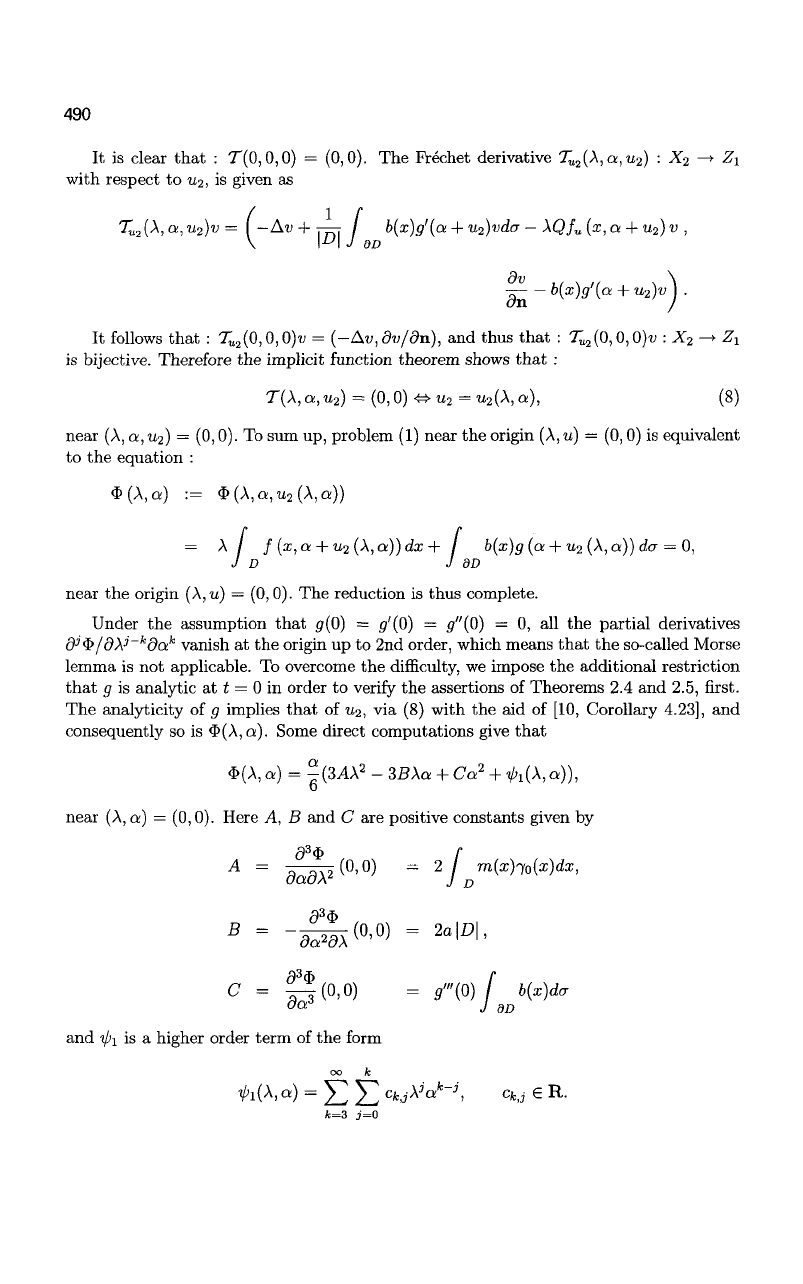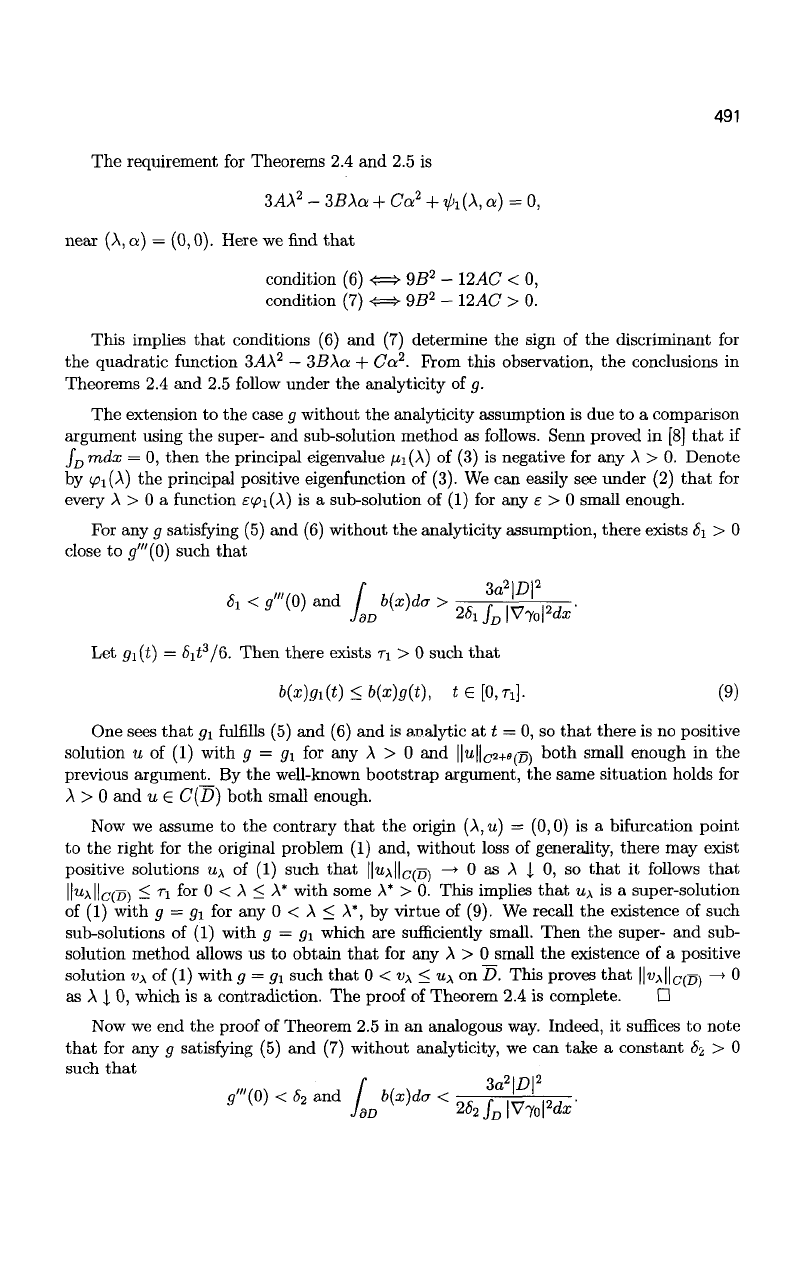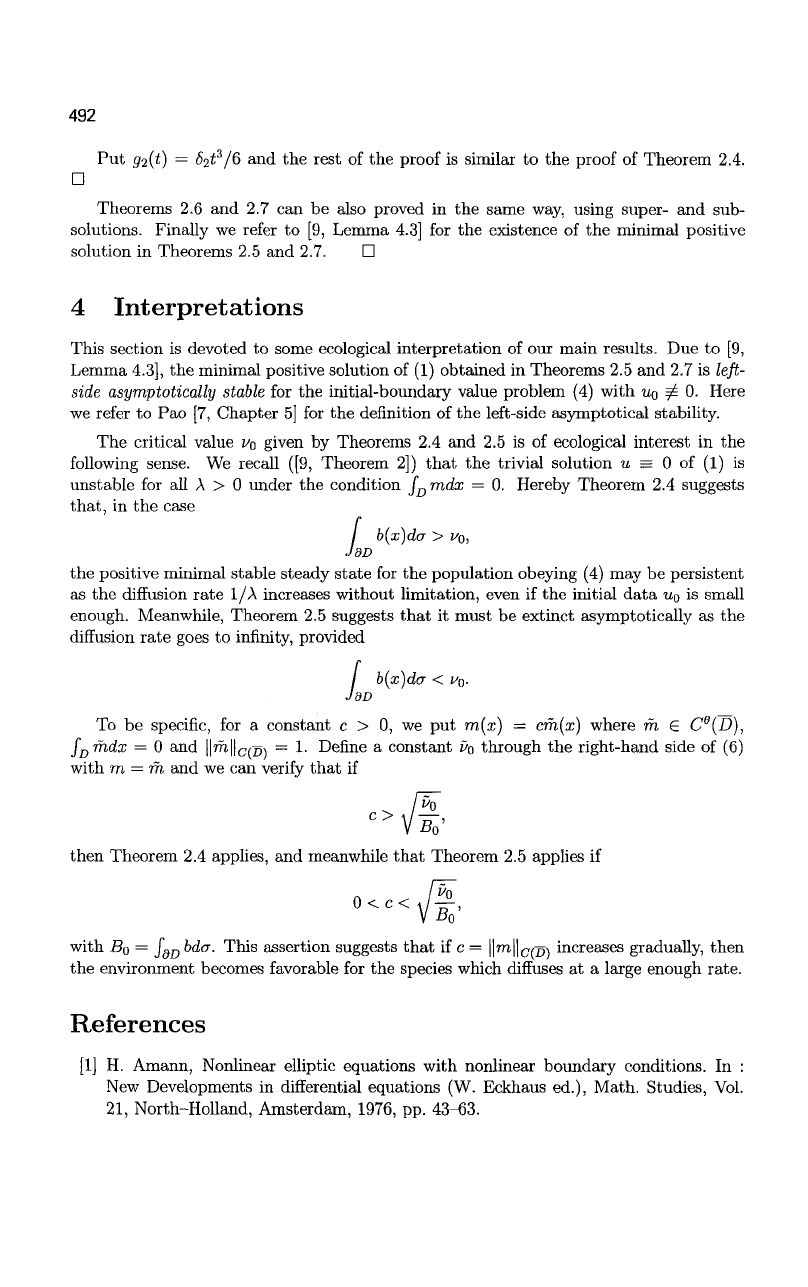Bemelmans J. et. al. (editor) Elliptic and Parabolic Problems: Rolduc and Gaeta 2001
Подождите немного. Документ загружается.


490
It is clear that : T(0,0,0) = (0,0). The Prechet derivative
T
U2
(X,a,u
2
)
: X
2
-> Zx
with respect to u
2
, is given as
T
U2
(A,
a,u
2
)v = I -Av + —- / b(x)g'(a + u
2
)vda - \Qf
u
(x, a + u
2
) v ,
V 1-^1 J OD
b(x)g'{a + u
2
)v
It follows that : T
U2
(0,0,0)v = (-Av,dv/dn), and thus that : T
U2
(0,0,0)v : X
2
-> Z
x
is bijective. Therefore the implicit function theorem shows that :
T(\,a,u
2
) = (0,0)<*u
2
= u
2
{\,a), (8)
near
(A,
a, u
2
) = (0,0). To sum up, problem (1) near the origin
(A,
u) — (0,0) is equivalent
to the equation :
#(A,a) := $(A,a,u
2
(A,a))
= A / / (x,a + «2
(\,a))dx
+ / b(x)g (a + u
2
(A,
a)) da = 0,
near the origin (A,u) = (0,0). The reduction is thus complete.
Under the assumption that ^(0) = </(0) = g"{0) = 0, all the partial derivatives
cP<&/d\i~
k
da
k
vanish at the origin up to 2nd order, which means that the so-called Morse
lemma is not applicable. To overcome the difficulty, we impose the additional restriction
that g is analytic at t = 0 in order to verify the assertions of Theorems 2.4 and 2.5, first.
The analyticity of g implies that of u
2
, via (8) with the aid of [10, Corollary
4.23],
and
consequently so is
<E>(A,
a). Some direct computations give that
$(A, a) = ^(3AA
2
- 3BAa + Co? + Vi(>,«)),
6
near
(A,
a) = (0,0). Here A, B and C are positive constants given by
a
3
*
dadX
2
(0,0) =• 2 / m{x)-y
0
(x
J D
)dx,
a
3
*
B
= -^
(0
'°) =
2a
^>
C = 0(0,0) =
g"'(0)J b(x)da
and ipi is a higher order term of the form
oo A;
ipx{\,
a) = 5Z H
c
kjXa
k
-
j
, c
kJ
€ R.
k=3 j=0

491
The requirement for Theorems 2.4 and 2.5 is
3A\
2
- 3BXa + Ca
2
+
V>i(A,
a) = 0,
near
(A,
a) = (0,0). Here we find that
condition (6)
<=>
9B
2
- Y1AC < 0,
condition (7) <S=> 9B
2
- Y1AC > 0.
This implies that conditions (6) and (7) determine the sign of the discriminant for
the quadratic function 3A\
2
—
3B\a + Ca
2
. Prom this observation, the conclusions in
Theorems 2.4 and 2.5 follow under the analyticity of g.
The extension to the case g without the analyticity assumption is due to a comparison
argument using the super- and sub-solution method as follows. Senn proved in [8] that if
J
D
mdx = 0, then the principal eigenvalue Hi{\) of (3) is negative for any
A
> 0. Denote
by ipi(X) the principal positive eigenfunction of (3). We can easily see under (2) that for
every A > 0 a function
E<pi(\)
is a sub-solution of (1) for any e > 0 small enough.
For any g satisfying (5) and (6) without the analyticity assumption, there exists
<5i
> 0
close to g'"(0) such that
t<™«-/
to
K.)*>
55
$g
p=
.
Let gi (t) = Sit
3
/6. Then there exists ri > 0 such that
b(x)
gi
(t)<b(x)g(t), te[0,n}. (9)
One sees that gi fulfills (5) and (6) and is analytic at t = 0, so that there is no positive
solution u of (1) with g = g
x
for any A > 0 and
||M||C2+«(C)
both small enough in the
previous argument. By the well-known bootstrap argument, the same situation holds for
A > 0 and u
G
C(D) both small enough.
Now we assume to the contrary that the origin (A,u) = (0,0) is a bifurcation point
to the right for the original problem (1) and, without loss of generality, there may exist
positive solutions u^ of (1) such that
||WA||C(D)
—» 0 as A J. 0, so that it follows that
II
U
A|IC(D)
< TI for 0 <
A
< A* with some
A*
> 0. This implies that ux is a super-solution
of (1) with g = gi for any 0 < A < A*, by virtue of (9). We recall the existence of such
sub-solutions of (1) with g = g\ which are sufficiently small. Then the super- and sub-
solution method allows us to obtain that for any A > 0 small the existence of a positive
solution v\ of (1) with g = g\ such that 0 < v\ < u\ on D. This proves that
||«A||C(5)
~~
y
0
as
A
J. 0, which is a contradiction. The proof of Theorem 2.4 is complete. •
Now we end the proof of Theorem 2.5 in an analogous way. Indeed, it suffices to note
that for any g satisfying (5) and (7) without analyticity, we can take a constant
&
z
> 0
such that
r 3n
2
IDI
2
5
"'(0)<5
2
and / b{x)da< * ' .

492
Put gi{t) =
5
2
t
3
/6
and the rest of the proof is similar to the proof of Theorem 2.4.
D
Theorems 2.6 and 2.7 can be also proved in the same way, using super- and sub-
solutions. Finally we refer to [9, Lemma 4.3] for the existence of the minimal positive
solution in Theorems 2.5 and 2.7. •
4 Interpretations
This section is devoted to some ecological interpretation of our main results. Due to [9,
Lemma 4.3], the minimal positive solution of (1) obtained in Theorems 2.5 and 2.7 is left-
side asymptotically stable for the initial-boundary value problem (4) with u
0
^ 0. Here
we refer to Pao [7, Chapter 5] for the definition of the left-side asymptotical stability.
The critical value v
0
given by Theorems 2.4 and 2.5 is of ecological interest in the
following sense. We recall ([9, Theorem 2]) that the trivial solution u = 0 of (1) is
unstable for all A > 0 under the condition J_ mdx = 0. Hereby Theorem 2.4 suggests
that, in the case
JdL
b(x)da > u
0
,
JdD
the positive minimal stable steady state for the population obeying (4) may be persistent
as the diffusion rate 1/A increases without limitation, even if the initial data u
0
is small
enough. Meanwhile, Theorem 2.5 suggests that it must be extinct asymptotically as the
diffusion rate goes to infinity, provided
JdD
b(x)da < u
0
.
To be specific, for a constant c > 0, we put m{x) = cfh(x) where m 6 C
e
(D),
J
D
rhdx = 0 and Hwll^m = 1. Define a constant
i>§
through the right-hand side of (6)
with m = rh and we can verify that if
c>
then Theorem 2.4 applies, and meanwhile that Theorem 2.5 applies if
0<c<
with B
0
= J
gD
bda. This assertion suggests that if c = ||m||
c
^ increases gradually, then
the environment becomes favorable for the species which diffuses at a large enough rate.
References
[1] H. Amann, Nonlinear elliptic equations with nonlinear boundary conditions. In :
New Developments in differential equations (W. Eckhaus ed.), Math. Studies, Vol.
21,
North-Holland, Amsterdam, 1976, pp.
43-63.

493
[2] K. J. Brown and S. S. Lin, On the existence of positive eigenfunctions for an eigen-
value problem with indefinite weight function. J. Math. Anal. AppL, 75 (1980),
112-120.
[3] R. S. Cantrell and C. Cosner, Diffusive logistic equations with indefinite weights:
population models in disrupted environments. Proc. Roy. Soc. Edinburgh, 112A
(1989),
293-318.
[4] R. S. Cantrell and C. Cosner, Diffusive logistic equations with indefinite weights:
population models in disrupted environments II. SIAM J. Math. Anal., 22 (1991),
1043-1064.
[5] M. G. Crandall and P. H. Rabinowitz, Bifurcation from simple eigenvalues. J. Funct.
Anal., 8 (1971), 321-340.
[6] P. Hess, Periodic-parabolic boundary value problems and positivity. Pitman Research
Notes in Math. Series, vol. 247, Longman Scientific & Technical, Harlow, 1991.
[7] C. V. Pao, Nonlinear
parabolic
and elliptic equations. Plenum, New York, 1992.
[8] S. Senn, On a nonlinear elliptic eigenvalue problem with Neumann boundary condi-
tions,
with an application to population. Comm. Partial
Diff.
Eq., 8 (1983), 1199—
1228.
[9] K. Umezu, Behavior and stability of positive solutions of nonlinear elliptic boundary
value problems arising in population dynamics. Nonlinear Analysis, TMA, to appear.
[10] E. Zeidler, Nonlinear functional analysis and its applications I: Fixed-point theorems.
Springer-Verlag, Heidelberg Tokyo, 1993.

Elliptic and Parabolic
SdtftJ-
ISM
Rolduc and Gaeta 2001
World Scientific
www.
worldscientific.com
5004
he
